How is the air heating of a private house
The use of air for heating a home is an attractive enough system, although we still prefer water. The difference between such methods of heating the rooms is quite decent, the efficiency of the first one is almost 90%, at the same time, the performance of the second is just below 60%. Today, our goal is to tell how you can make air heating of a private house with your own hands, as well as learn about its advantages over others.
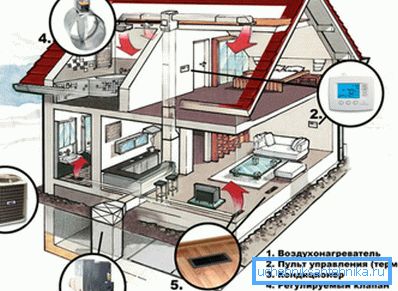
Why consumers choose it
Air heating is practical. Below we consider what this is expressed in:
| Security |
|
| Speed | The owners of the system note the short period required to warm the entire room. For example, from negative to comfortable temperatures it will take about 40 minutes or a little less. |
| Efficiency | High performance air heating makes it possible to save electricity. Due to the absence of intermediate coolants, such heating of a private house becomes extremely profitable. The total cost of heating costs will be lower in the end. |
| Reliability | Competent design of air heating, its installation, regular maintenance and timely repairs allow the system to be used for more than 20 years. |
| Exploitation | The use of automatic process control, including starting, stopping and changing modes, makes it possible to easily adjust the temperature in the house and at the same time protects against possible errors. |
| Aesthetics | In this case, the room does not provide for the installation of traditional radiators, so you can install windows of any size. Space is freed up, and opportunities for design solutions are opening up. |
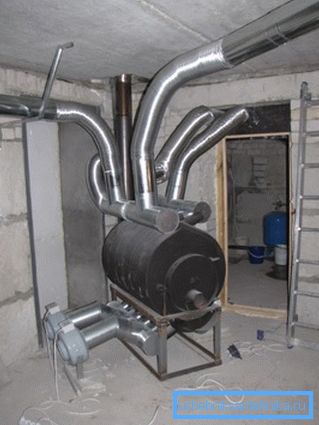
Principle of operation
The air heating system involves the use of a heat source. The air is first injected into the heat exchanger, where it warms up to 45-60 ° C, after which it moves through the air ducts and heats the room. The cooled air enters the heat generator again, using return air ducts or floor grids.
You can warm the air using:
- heat pump;
- gas burner using liquefied or main gas;
- hot water from a centralized boiler room;
- diesel burner.
On average, air flow ranges from 1,000 to 3,800 m3/ h, the pressure should be 150 Pa.
Recommended duct length:
- main - up to 30 m;
- branches - up to 15 m.
Tip: if heat losses start to occur in large rooms due to the length of the ducts, use several heat generators in the system that work without ducts.
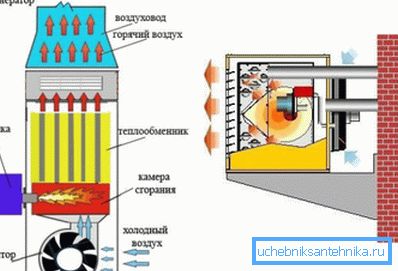
We recommend not to use such an air system solely for heating a house. It will be more rational to combine heating with air conditioning, which will allow to maintain a comfortable temperature in the rooms at any time of the year. We also offer to equip it with additional equipment that can create the necessary microclimate, in particular, a sterilizer and a humidifier.
Ways of arrangement
An air heating system can be created on the basis of:
- Natural ventilation, what is the easiest option when the air begins to rise due to the initial heating. It enters the rooms of the house through air ducts, heats them and returns to the heat exchanger.
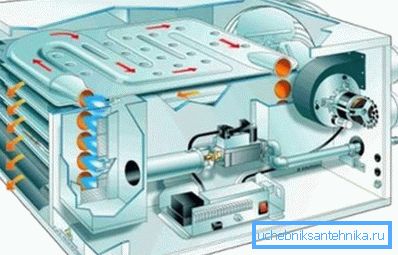
Deficiencies will begin to occur when additional cool air enters through the windows and doors. It turns out that there are more cold air masses, they accumulate in the lower part of rooms, because of which a temperature imbalance is created, which interferes with normal functioning.
- Forced ventilation, when air circulation occurs due to the fan, creating the necessary pressure in the system. The rooms in the house because of this warm up much faster, as the speed of movement of air masses increases. Adjusting the temperature in rooms using devices with mechanical ventilation is easier. The disadvantage is the noise from the movement of air through the air ducts.

Equipment selection
Different types of fuel can be used to operate heat generators. It is very important to choose the most suitable option. For example, it can be natural or liquefied gas, as well as diesel fuel.
Manufacturers have provided the option of a possible transition from one fuel option to another without any problems. In this case, the instruction requires only to replace the burner or to install a replaceable nozzle.
Tip: liquid fuel requires the installation of special filters, storage tanks for fuel, the supply of the pipeline to it.
For the installation, which will work on liquefied gas, it is also necessary to provide a room for storage of cylinders or gas tank. Natural gas systems do not require additional conversions.
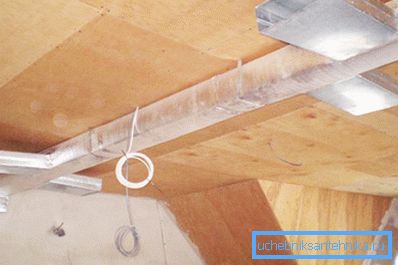
Air ducts can be used round, with O100-200 mm, and also rectangular, if a larger section is required. The latter can be more harmoniously fit into the interior. They are usually fixed with anchors to the ceiling, and in unheated areas they carry out insulation. In the premises install air intake grilles and air distributors.
Conclusion
It is economical, safe, simple, reliable and durable to heat an apartment with air. Therefore, this method attracts more and more consumers every year. The only drawback is the complexity of the installation, so it is better to entrust it to specialists.
The video in the article will help you find additional information on this topic.